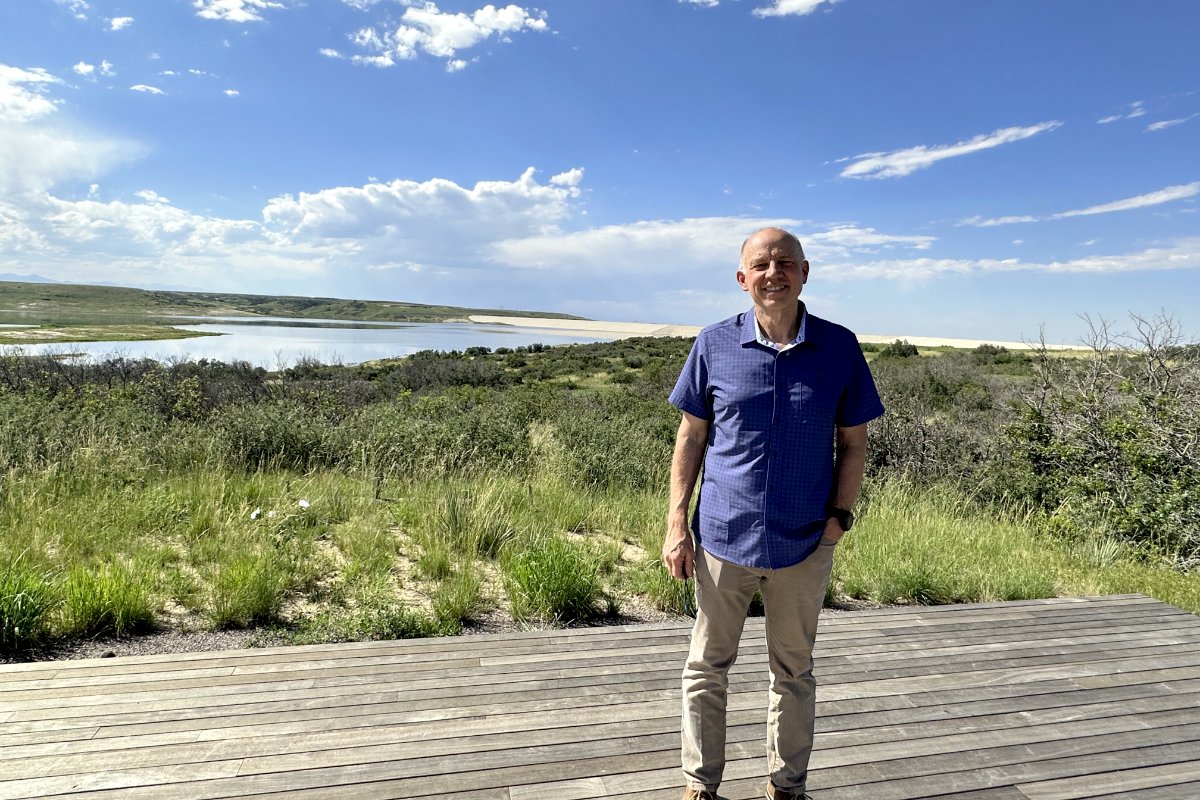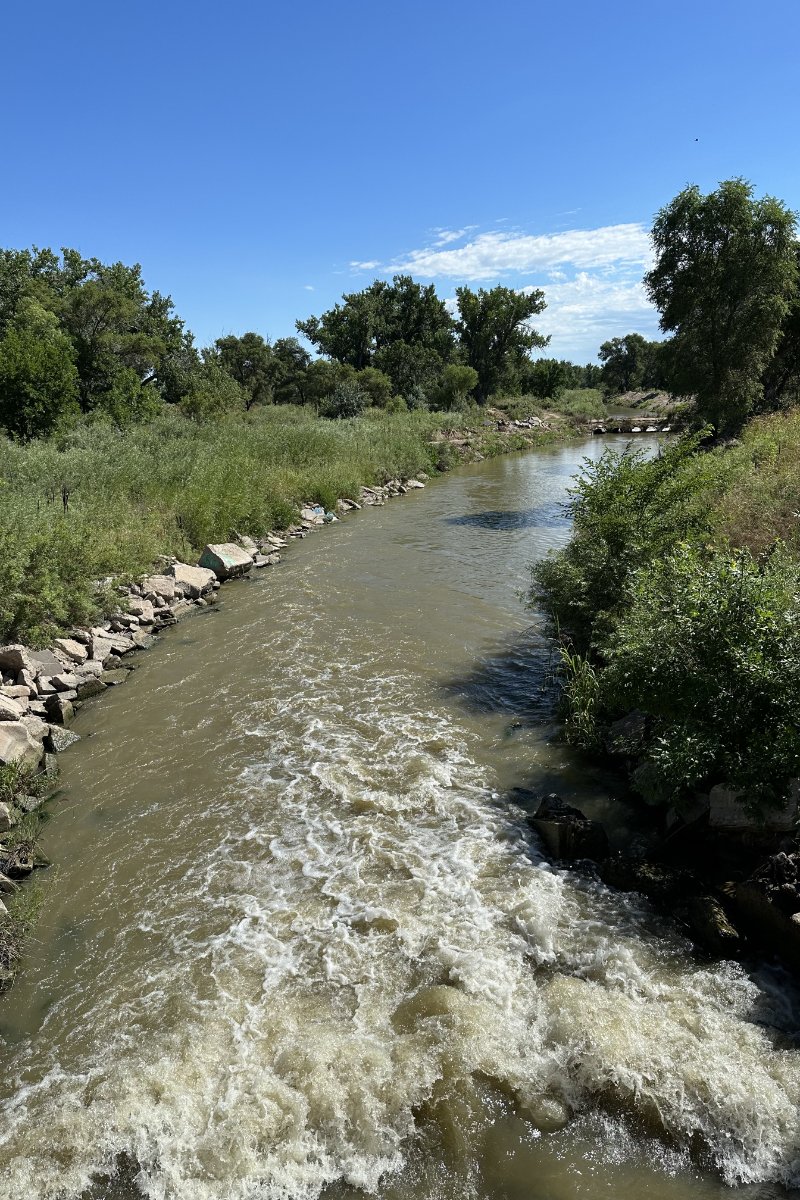A group seeking to buy water from farm and ranch lands is turning its efforts to electing water board representatives—who could then make water deals with suburbs easier.

A group seeking to buy water from farm and ranch lands is turning its efforts to electing water board representatives—who could then make water deals with suburbs easier.
September 13, 2023

Photo credit: Thomas Barwick, Getty Images
Private investors seeking to sell groundwater from parched parts of Colorado to a Denver-area water utility are spending tens of thousands of dollars to elect candidates to the water boards that govern the constrained supplies.
The investors are behind Renewable Water Resources (RWR), a company that failed a year ago to obtain $10 million in pandemic-relief funds from Douglas County, located south of Denver and one of the nation’s wealthiest counties. RWR sought the funds to kickstart a plan to drill deep wells on a ranch it owns in the San Luis Valley farther south, home to the nation’s second-largest potato crop. RWR is aiming to plumb an aquifer underneath to sell water to the Denver area for a profit, despite significant public backlash from the valley’s farmers and residents, who depend on it.
Now, RWR’s principals have helped elect candidates, and, in one case, an RWR principal himself, to Douglas County water boards.
“We got on RWR’s radar because we have been saving money for 10 years,” said Ron Redd, manager of the Parker Water & Sanitation District in Douglas County, as he recently stood under the searing sun overlooking a 10-year-old reservoir. Redd has been working to fill the reservoir partly with water piped south from the high plains. “We have $60 million sitting in the bank and that catches peoples’ attention.”

Ron Redd, manager of the Parker Water & Sanitation District in Douglas County, stands on a platform overlooking the Rueter-Hess Reservoir where the district stores water for its customers. (Photo credit: Jennifer Oldham)
RWR’s efforts to stack the Parker board imperils the funds, set aside to implement a nationally recognized water sharing agreement between the city and farmers on the water-short eastern plains, Redd said. That’s because new board members could potentially upend those plans by directing the money elsewhere, including to water-for-profit deals like those proposed by RWR.
Redd has already turned down RWR’s invitations to buy water twice; as a utilities director in another community, Castle Rock, in 2002, and again in Parker two years ago.
The agreement is a marked departure from typical “buy and dry” deals, in which a municipality purchases water from a group of farmers or ranchers, drying up the land it once irrigated. Such accords have already led to economic and environmental disaster across the West.
Instead, the Parker district has forged an estimated $880 million deal with ranchers in Colorado’s most agriculturally productive region to capture and store water from the South Platte River during rare periods when supply exceeds demand. Known as the Platte Valley Water Partnership, their unique arrangement would allow city dwellers and farmers and ranchers—who hold the most senior water rights in the West—to share the cost of several reservoirs and a pipeline. Rural and urban residents would then split water stored during wet periods in the northern part of the state for use in prolonged dry spells. The agreement enjoys unusually broad political support and complies with the state’s water plan, which emphasizes water-sharing between municipalities and producers.
The agreement is a marked departure from typical “buy and dry” deals—akin to the one proposed by RWR—in which a municipality purchases water from a group of farmers or ranchers, drying up the land it once irrigated. Such accords have already led to economic and environmental disaster across the West.
As Redd and officials at the Lower Platte Water Conservancy District, the other party to the agreement, seek to usher the partnership through permitting and design, it’s not clear whether the board will back them. The five-member body must approve all contracts and spending decisions associated with the plan—giving RWR’s water-board efforts potentially significant power to shape where the water flows.
Farmers 300 miles to the north of the San Luis Valley on Colorado’s eastern plains oppose RWR’s plans. There isn’t enough water to go around in either region, where rivers are over-allocated, aquifers are shrinking, and farmers use an estimated 80 percent of the water. The driest period in more than 1,200 years has forced producers in both areas to curtail well water use, fallow farm land, and sell cattle. Potato shipments from the San Luis Valley fell by 100 million pounds in 2022, about 6 percent off the yearly average.
Federal officials designated the entire state a disaster area in December due to extremely arid conditions. Then spring and summer brought a marked reprieve as precipitation was up in much of Colorado, illustrating climate change’s unpredictable and extreme effects on growers livelihoods.

An irrigation ditch carrying water away from the South Platte River is unusually full for August due to a record wet spring in northeastern Colorado. (Photo credit: Jennifer Oldham)
Northeastern Colorado inked its wettest period on record from May through July. The San Luis Valley, on the other hand, recorded the driest July in the 129-year record. Such variations directly affect the state’s bottom line: Agriculture is its second largest moneymaker, generating $11.9 billion in output in 2019.
For third-generation farmers like Gene Manuello, water that recently cascaded down the South Platte River past his ranch represents a missed opportunity to save the precious resource during a rainy summer.
“We could actually be taking water out of the river right now and using it under the Platte Valley Water Partnership by putting it in a reservoir, or pumping it to Parker,” said Manuello, as he stood near a ditch brimming with water diverted from the river that his family has relied on to sustain its crops and cattle for the better part of a century.
“That wouldn’t be the norm for most years,” he added.
Rancher Gene Manuello points to a rubber gate that forces water out of the South Platte River and into an 150-year-old irrigation ditch he uses to water alfalfa and corn to feed his cows. (Photo credit: Jennifer Oldham)
Additional storage is particularly important for producers who rely on groundwater. Pumping restrictions were imposed on well users last year, prohibiting them from storing river water in ponds, where it sinks in and replenishes the aquifer. Shortfalls are expected to increase.
“This project would help in a lot of years when these wells are curtailed,” said Joe Frank, general manager of the Lower South Platte Water Conservancy District, as he gestured toward a concrete pump house used to divert water from the river into ditches about 50 miles south of Manuello’s ranch.
Now, RWR officials could significantly influence that plan. They already have ties to two board members in the Parker Water & Sanitation District, which is spearheading the effort with the Lower South Platte Water Conservancy District, according to interviews and filings with the Colorado Secretary of State. One is Board Secretary Brooke Booth, elected in 2022, who is related by marriage to Sean Tonner, an RWR principal, Redd said.
RWR investors John Kim and Hugh Bernardi have also given tens of thousands of dollars to other candidates’ elections. Kim gave $5,000 and Bernardi $11,000 to Robert Kennah, who won a four-year director-at-large term in May. Bernardi gave $5,000 and Kim $11,000 to Kory Nelson, who lost to incumbent board President Merlin Klotz. Nelson is contesting the results in court.
The double-digit contributions in a water district election raised red flags for Klotz, a former Douglas County clerk and recorder.
“They are in the business of skinning dollars off of trading water,” Klotz said, who emphasized the vulnerability of the district’s assets in this scenario, valued at over one billion dollars. “We are in the business of supplying the community—our motives are different than their motives.”
Typically, such contests draw scant attention and little money. Only a fraction of the 37,683 ballots delivered to district customers were returned—Kennah won with 1,730 votes and Klotz with 1,520, beating Nelson by 26 votes, hand-written certified results show.
In an interview, Kim said he gave the money to Nelson and Kennah’s campaigns because he’s “a long-time resident here in Douglas County, and I wanted to participate in the political process on an issue I think is important for Douglas County.”
“They are in the business of skinning dollars off of trading water. We are in the business of supplying the community—our motives are different than their motives.”
The commercial real estate investor added that he thinks water districts need to look closely at opportunities to develop new water supplies.
“I think Douglas County is a growing community and we need to make sure we have the appropriate water resources,” said Kim, who won a seat on the Roxborough Water & Sanitation District in 2022 and is now its treasurer. That district held $116 million in assets at the end of the 2022 fiscal year.
Bernardi, Kennah, Booth, and Nelson didn’t return requests for comment.
Kennah and Nelson agreed during an April radio interview, however, they would like to help the Parker district “secure good quality sources to fill their reservoir,” in a nod toward RWR’s project.
“We need to look at the long term and a commitment to work with the other regions in securing those primary use rights,” said Nelson. “The whole issue about the San Luis Valley and talking about that water source—we need to take a real hard look at that.”
The stakes are rising for municipalities in the West that are searching to buttress water supplies from dwindling aquifers as scarce renewable surface water, escalating growth, and climate change accelerate problems.

Water sprays from a pivot sprinkler onto an alfalfa field that is part of Gene Manuello’s family’s cow and calf operation near Sterling, Colorado. (Photo credit: Jennifer Oldham)
Parker’s water district is a case study in the wrenching choices urban and rural residents will be forced to make around how to allocate shrinking water supplies. A state plan released this year offered this dire forecast for Colorado’s water future: “Municipal, industrial, and agricultural gaps are projected to occur in all scenarios.”
Districts must decide whether to ink deals with investors like RWR, which view brokering water as a money-making opportunity.
Eschewing such deals is a top priority of water managers like Joe Frank. White pelicans floated nearby as Frank stood on the banks of the South Platte River recently, remembering the exact time and date gauges showed that the waterway had more than enough for everyone: 5 a.m. on May 12.
The region’s intricate irrigation system is designed to allow water to flow back into the river from farm fields, replenishing the South Platte and allowing supplies to be reused. But that system is imperiled if ranchers and cities continue to forge buy-and-dry deals, Frank said. For example, the city of Aurora in March purchased farmland and water rights near Greeley, about 100 miles west, with plans to transfer the water to urbanites for good.
In Parker, managers and several long-term district board members don’t want to rely on buy-and-dry deals. Farmers and municipal water providers agree they want to set a precedent for how to equitably share water in an increasingly arid future. And other nearby cities have already indicated that they would be interested in participating in the Platte Valley Water Partnership. This vision is now in jeopardy, they said.
“I expect RWR is laying plans to get a third board member on in the next election in May 2025,” said Redd, Parker water’s director. “We’ve worked so hard to make sure the partnership is something we can afford—if these investors get taken care of, the community suffers.”
Communicating those risks to the district’s customers clearly is difficult, however. Kennah and Nelsons’ campaigns paid Cutter Consulting LLC to do advertising on social media, signs, text blasts, direct mail to voters, and website development, according to records on file with the secretary of state.
“We’ve worked so hard to make sure the partnership is something we can afford—if these investors get taken care of, the community suffers.”
Jack Cutter, the firm’s owner, has ties to RWR principal Kim. Kim’s campaign for the Roxborough water district board paid the firm $8,497.21 in April 2022 to conduct social media outreach and to handle banners and direct mailers, secretary of state records show. Cutter did not return a request for comment.
RWR’s attempts to influence decisions made by Denver-area utilities marks the latest turn in a 30-year quest by private investors to profit off water from the Massachusetts-sized San Luis Valley.
The firm’s attempt to sell the project to Douglas County failed last year in part after the county’s attorneys found that there was no unallocated water in one of the two aquifers RWR proposed to tap.
The arid area’s 46,000 residents defeated three other proposals, prevailing both in court and in public processes. Colorado Governor Jared Polis, Attorney General Phil Weiser, and U.S. Senators Michael Bennet and John Hickenlooper, all Democrats, oppose RWR’s plans.

October 9, 2024
In this week’s Field Report, MAHA lands on Capitol Hill, climate-friendly farm funding, and more.
October 2, 2024

October 2, 2024

October 1, 2024

September 30, 2024

September 25, 2024

September 25, 2024

Like the story?
Join the conversation.